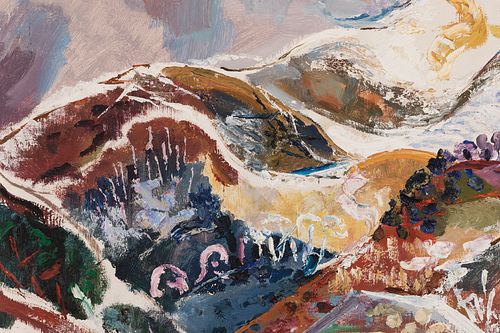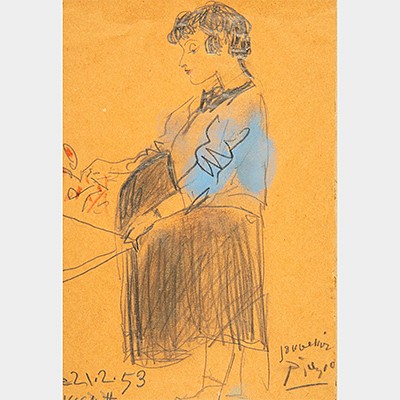MENCHU GAL (Irun, 1918 - 2008). "Snowy landscape". Oil on panel. Presents label of the Biosca Gallery (Madrid). Work exhibited at the IVAM Exhibition.
Lot 76
About Seller
Setdart Auction House
Carrer Aragó 346
Barcelona
Spain
Setdart Subastas was born in 2004 and is currently the first online art auction in Spain with solidity, prestige and reliability guaranteed by our more than 60,000 users. Setdart has a young, dynamic and enterprising team ready to successfully manage the purchase and sale of art works through custom...Read more
Categories
Estimate:
EUR€30,000 - EUR€40,000
$32,258.06 - $43,010.75
Absentee vs Live bid
Two ways to bid:
- Leave a max absentee bid and the platform will bid on your behalf up to your maximum bid during the live auction.
- Bid live during the auction and your bids will be submitted real-time to the auctioneer.
Bid Increments
| Price | Bid Increment |
|---|---|
| EUR€0 | EUR€10 |
| EUR€200 | EUR€25 |
| EUR€500 | EUR€50 |
| EUR€1,000 | EUR€100 |
| EUR€3,000 | EUR€200 |
| EUR€5,000 | EUR€500 |
| EUR€10,000 | EUR€1,000 |
| EUR€20,000 | EUR€2,000 |
| EUR€50,000 | EUR€5,000 |
About Auction
By Setdart Auction House
Sep 20, 2021
Set Reminder
2021-09-20 08:00:00
2021-09-20 08:00:00
America/New_York
Bidsquare
Bidsquare : CONTEMPORARY ART
https://www.bidsquare.com/auctions/setdart-auction-house/contemporary-art-7482
Setdart Auction House sofia@setdart.com
Setdart Auction House sofia@setdart.com
- Lot Description
MENCHU GAL (Irun, 1918 - 2008). "Snowy landscape". Oil on panel. Presents label of the Biosca Gallery (Madrid). Work exhibited at the IVAM Exhibition. Menchu Gal: A free spirit, 2012. Signed in the lower right corner. Measurements: 61 x 81 cm; 82 x 102 cm (frame). Landscape painting was one of the pillars of Menchu Gal's artistic career, especially from the 1960s onwards. The artist devoted many of her works to collecting her landscape impressions, which were based on a figurative concept imbued with a certain lyricism that turned the object of her art into an evocation of the landscape itself. In her paintings she does not reproduce exactly what her eyes see, but rather the sensation produced by the motif through her sensibility. First she appropriates reality, then she subjectivises what she observes, filtering it through the sieve of her personal experiences, and the result is projected onto the support, which returns us to a poetised reality". One of the great Spanish painters of the 20th century, Menchu Gal mainly painted landscapes, although she also painted portraits, always with her personal language of extreme, almost expressionist colour. In 1959 she won the National Painting Prize, becoming the first woman to receive this prestigious award. She also received the Gold Medal of Guipúzcoa (2005), the Medal of Irún (2006) and the Manuel Lecuona Prize of Eusko Ikaskuntza (2006). Gal began painting in her native Irun, where she was a disciple of Gaspar Montes Iturrioz. She was awarded a prize in the Gipuzkoa New Artists Competition in 1932, and before she was fifteen years old she moved to Paris to further her artistic studies. There she received classes from the master of cubism, Amédée Ozenfant, and discovered Matisse and Fauvism. On returning to Spain he continued his training at the San Fernando School of Fine Arts in Madrid, where he was taught by Aurelio Arteta and Vázquez Díaz, among others. After fleeing to France as a result of the Civil War, he returned to Irún and held his first individual exhibition in San Sebastián (1942). In 1943 he settled in the Spanish capital, where he formed part of the so-called Madrid School. That same year he took part in a group exhibition held at the Clan gallery together with Gutiérrez Solana, Vázquez Díaz, Cossío, Zabaleta, Palencia and others. From then on her landscapes of La Mancha and the Bidasoa formed her hallmark, establishing herself as one of the leading artists of the post-war period. In 1950 she held a solo exhibition at the National Museum of Modern Art in Madrid. An outstanding architect of the renewal of Spanish painting in the 1940s, valued and recognised in the difficult world of painting from her youth, Menchu Gal was characterised by her free, heterodox and independent spirit, ahead of her time. Throughout her career she staged a multitude of exhibitions, both in Spain and abroad, in cities such as Venice, Brussels and New York. Particularly noteworthy were the exhibitions he held at the Gulbenkian Foundation in Lisbon in 1971 and at the Conde Duque Cultural Centre in Madrid in 1990. In 1992 the Kutxa Foundation dedicated a retrospective exhibition to him, the catalogue of which included an in-depth study of his life and work. She also participated in three editions of the Venice Biennale. Menchu Gal is currently represented at the Museo Reina Sofía in Madrid and the Museo de Bellas Artes in Bilbao, among others. In January 2010, an exhibition hall bearing her name was opened in Irun, the first step in the future Museum of Painters of Bidasoa.
- Shipping Info
-
In-house shipping available. Please inquire at admin@setdart.com.
-
- Buyer's Premium



 EUR
EUR CAD
CAD AUD
AUD GBP
GBP MXN
MXN HKD
HKD CNY
CNY MYR
MYR SEK
SEK SGD
SGD CHF
CHF THB
THB








